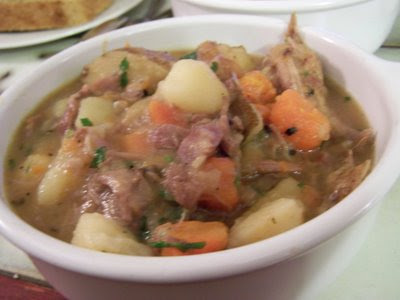
Here's a new one from the Southern food files: chicken and dumplings, aka chicken and pastry.
Southern dumplings are completely different from what we think of as dumplings, Mom -- these are more like big noodles, like those big 3" square Thai rice noodles except made out of soft wheat flour.
Most people here call the dish chicken and dumplings, but Lawson's dad's family calls it chicken and pastry, which I think is more descriptive. For me, the word "dumpling," what with that "plump" assonance and my own childhood memories, just describes balls of dough better than flaps of dough. So pastry it is.
There's another key way in which Southern chicken and dumplings is different from what we make elsewhere, and this difference took me longer to understand. It's not a soup, although it's made with a bunch of broth. It's got no vegetables, and it's not heavily seasoned. It's more like chicken and noodles in gravy. The dumplings thicken the stock as they cook, and you serve the chicken and dumplings on a plate or flat bowl with just some of the liquid, which clings to everything like a sauce. Vegetables go on the side.
Here is Lawson's grandma's recipe for chicken and pastry, as written down by his...maybe great aunt?:
Make a hole in the center of a pan full of self-rising flour. Get a cup full of hot chicken broth and pour it into the hole. Take a fork and stir it around and work in enough flour to make a firm ball. On a floured surface, roll it out thin. Leave it for a couple of hours to "die." (I don't know if you would have to "let it die" if you used all-purpose flour, we never had any of that kind at our house.) Then cut into thin strips and drop into the boiling pot of broth and chicken. Cook until tender, (not long).
Lawson remembers watching his grandma make chicken and pastry when he was a kid, so he was able to fill in some of the holes in that recipe for me. I also looked at Jean Anderson's instructions in the cookbook you gave me, Mom, and a few other places. And here's what I did:
Chicken and PastryRoast a chicken. Eat half of the meat at one meal. Pick the other half of the meat off and save for chicken and pastry.
Make stock with the carcass, skin, pan drippings, an onion, and a carrot.
(Most traditional recipes call for starting with a whole chicken and boiling it. But most traditional recipes are for tough old hens that have stopped laying, not grocery store roasters. Roasting the chicken first gives a bland bird more flavor. And since we can get several two-person meals out of one chicken, there's no use just boiling the whole thing.)
When the broth is finished, make the pastry dough:
- 2 cups white all-purpose flour -- I used White Lily.
- 1 and 1/2 teaspoons salt
- warm broth, not yet skimmed -- I used a bit less than a cup, but this will vary.
Mix together with a fork just until doughlike. Do not knead. Form into ball and set aside.
Skim the fat off the broth and heat the broth in a clean pan. Add salt, pepper, a fresh sage leaf, and a sprig of thyme and simmer for 10-15 minutes, long enough to get the flavors smoothed out.
Roll out the pastry on a floured counter. At first I rolled it to about 3/8", but Lawson said it should be still thinner, almost translucent, so I did that. Later we decided the thicker pieces were a bit better -- they had some chewy substantialness that was lacking from the thin ones.
Cut the pastry with a knife into rectangles about 2" x 3".
Add the chicken meat to the broth and bring to a boil. It should be a big rolling boil. I didn't like it and tried to convince Lawson to turn it down, though he swore he remembered a ferocious boil -- I thought it would make the broth taste scorchy and flat. But I understood after we put the pastry in that the broth has to be moving and hopping furiously to keep the pastry from sticking to other pieces. So do that.
Drop the pastry pieces one at a time into the pot. Once all the pastry was in, it probably took about 15 minutes for everything to cook through and the broth to thicken slightly.
We ate it with green beans boiled and then tossed with lemon zest and a touch of butter. Very simple, and perfect on a cold wet January night in South Carolina.
 I always make soup or stew for company arriving by airplane, because terrible things can happen to the timing of dinner. If possible, I leave it in the crockpot while we drive to the airport.
I always make soup or stew for company arriving by airplane, because terrible things can happen to the timing of dinner. If possible, I leave it in the crockpot while we drive to the airport.


























 This whole January 1st meal was a New Year's resolution: pasta e fagioli (I used black-eyed peas for good luck); low-gluten bread; and a very fresh green salad.
This whole January 1st meal was a New Year's resolution: pasta e fagioli (I used black-eyed peas for good luck); low-gluten bread; and a very fresh green salad.

